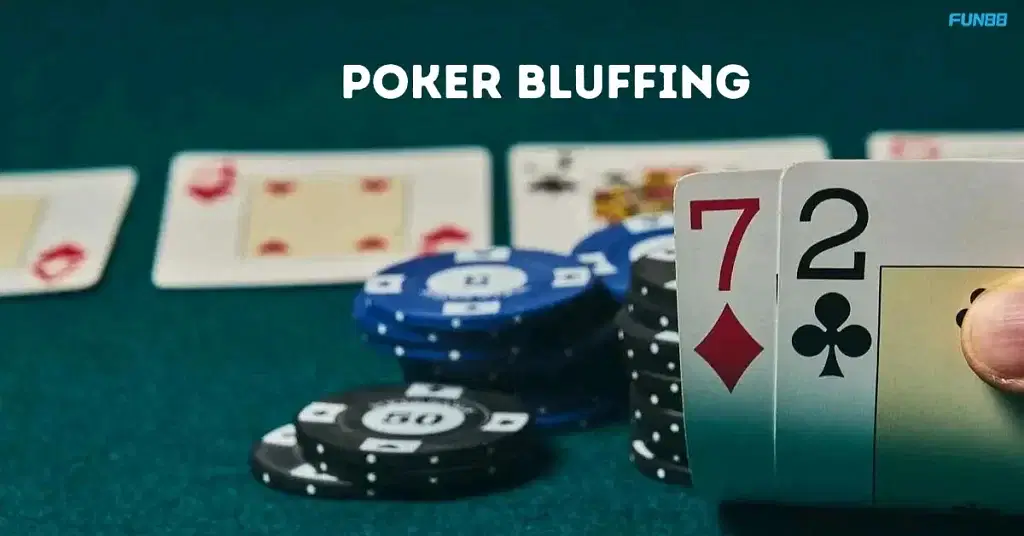For many, poker is the epitome of strategy combined with a dash of luck. But what sets an amateur apart from a seasoned player? Often, it’s the skill of bluffing. Knowing when and how to bluff effectively can transform your poker game, making it both a thrilling and rewarding experience.
Understanding the Bluff
At its core, poker bluffing is about deception; it’s the ability to convince opponents that your hand is stronger than it is. While it sounds straightforward, in practice, bluffing demands a nuanced understanding of human psychology, game dynamics, and strategic timing.
The Psychology of Bluffing
- Reading Opponents: One must be adept at reading the table. Observe opponents’ betting patterns, body language, and behavioural shifts. These clues can reveal their hand strength, guiding your bluffing decision.
- Emotional Composure: Your body language matters. Maintaining a poker face—literally and figuratively—helps sell your story. Shifts in your demeanour during a bluff must match the narrative you wish your opponents to believe.
Decoding Timing: When to Bluff
The efficacy of a bluff heavily relies on timing. Knowing when to execute this tactic ensures it remains effective, avoiding patterns opponents can easily decode.
- Early Game Caution: In the initial rounds, tread carefully with bluffs. Players are typically conservative, focusing on hand development rather than large risks. Surprisingly, bluffs here may catch them off guard, but they can also be equally dangerous.
- Middle Rounds Strategy: Mid-game is where poker tactics often involve strategic bluffs. By now, you’ve observed others enough to make educated guesses about their Poker hands. Use this phase to introduce bluffs and subtly probe their reactions.
- Endgame Aggression: As blinds increase, bluffing can be a powerful tool. Players might be more willing to fold, guarding their chip stacks for better opportunities. Well-timed aggression can force weaker opponents to bail on potential hands.
Bluffing Techniques That Work
- Semi-Bluff: This involves betting on a hand that isn’t yet strong but has potential. For example, you hold a flush draw. If opponents fold, fantastic; if not, you still have outs to improve your hand.
- Stone-Cold Bluff: This is riskier, as you bet aggressively on a weak hand. Use it sparingly; once discovered, frequent stone-cold bluffs can damage your credibility at the table.
- Continuation Bet: After raising pre-flop, make a continuation bet post-flop even without improvement. This maintains pressure on opponents, implying continued hand strength.
- Over-Bet Bluff: Sometimes, an over-bet—betting significantly more than the pot—can suggest extreme confidence. Opponents might fold, assuming you have a monster hand trying to extract maximum value.
Mastering the Art of Storytelling
Bluffing is as much about narrative as it is about strategy. Each bet and raise should weave a tale aligning with the preceding and following actions.
- Consistency is Key: Actions that contradict your bluffing story are the easiest ways for opponents to detect deception. Ensure your betting pattern supports the hand you’re representing.
- Control the Pace: Speed of play can influence perceptions. Decisive, rapid actions might signal extreme confidence or desperation. Balance your timing to match the narrative of strength you aim to project.
Diversifying Your Bluff Portfolio
Bluffs can become predictable if repeated without variation. Introducing layers and differing bluff styles keeps opponents uncertain about your intentions.
- Mix in Value Bets: To keep bluffs credible, mix them with genuine hands that warrant aggressive betting. This misleads opponents into questioning whether your aggression is legitimate or a ruse.
- Occasional Check-Raise Bluffs: This bold move can unsettle opponents. By checking initially, you invite a bet only to follow with a raise. The dramatic shift can suggest you hold a strong hand, prompting folds.
Also Read: Ultimate Poker Cheat Sheet – Quick Tips for Success
Ethical Considerations in Bluffing
While bluffing is integral to poker, ensure it remains within the game’s spirit. Respect for opponents’ intelligence and dignity is paramount; never rely on abusive deception or exploitative behaviour. The game thrives on mutual respect and competition.
Recognising When to Refrain
Not every situation warrants a bluff. Sometimes, the best strategy is honesty, particularly against newer players who might not be adept at reading complex moves or against seasoned players who can easily spot bluffs.
- Against Calling Stations: These players will see through or suspect bluffs and readily call, making them poor bluff targets. Modify strategies to adopt straightforward plans when facing them.
- In Multi-Way Pots: Bluff effectiveness diminishes with more opponents. The risk increases as chances improve that someone holds a genuinely strong hand. Bluff sparingly when facing multiple players.
Practicing and Perfecting Bluffing
Mastery of poker bluffing requires practice. Engage in regular play, reflecting on successful and failed bluffs to refine your strategies.
- Review and Analyse: After games, review your bluffs—successful or not—and assess what factors contributed to their outcomes. This analysis enhances future decision-making.
- Simulations and Skills Development: Use online poker tools and simulations to test and develop bluffing tactics in a risk-free environment. Analysing different scenarios hones reaction and adaptability.
The Role of Position in Bluffing
Position in poker refers to where a player sits about the dealer button. Your position significantly influences your bluffing tactics. Acting later in a hand offers insights into other players’ actions and hand strength before you make your move. Therefore, players in late positions generally have more strategic bluffing opportunities.
When seated in an early position, proceed with caution. Bluffing is tricky because you’re acting without concrete knowledge of opponents’ hands. Laying a good bluff means risking your stack with little information. Hence, bluffs from early position should be rare and well-calculated, often focusing on reads or perceived table images.
Conversely, being in a late position allows you to bluff with more context. If opponents have shown weakness, such as checking multiple times, a well-timed bluff can persuade them to fold. This is especially true in scenarios where everyone checks post-flop, signalling no strong hands. In such cases, a modest raise may convince others your hand is superior.
Yet, understanding position isn’t just about geography on the table; it’s about storytelling. An effective position-based bluff is crafted from the information gathered in the hand’s progression, not solely on your Poker cards. Skilled players use their position to craft narratives that naturally blend into the game’s ongoing drama.
Moreover, effectively leveraging position is about controlling the pot size. Use it to manipulate the flow of the hand, test the waters with information bets, and gauge opponents’ reactions. Only bet when the story flows seamlessly with the table’s energy, minimising the chances of getting called out on your deception.
Thus, mastering positional awareness aligns your strategic moves with the grander theatrical play of poker, making your bluffs more powerful and convincing.
The Impact of Table Dynamics on Bluffing
Table dynamics in poker refer to players’ overall environment, pace, and behaviour patterns during a game. These dynamics are fluid, shifting with each hand played, requiring constant adaptation in your poker tactics. Understanding and leveraging these dynamics is crucial in determining when to employ bluffs effectively.
When seated at a passive table where players rarely bet aggressively, strategic bluffs can break inertia and induce folds. Here, bluffs act as sudden jolts, prompting players to rethink their hands and fold marginal cards out of caution.
Conversely, at an aggressive table where bets come swiftly and often, the art of bluffing requires refinement. Over-aggression by bluffing frequently in such dynamics can prove costly, as the likelihood of someone challenging your bluff increases.
Additionally, consider the individual personalities constituting the table. Against seasoned pros, your bluffs require intricate layers since they’re vigilant and often suspicious of aggressive moves. In contrast, newer players or those unaccustomed to live play might react differently, either folding too easily or calling when they should fold.
The pace of play also influences bluff decisions. A sluggish game indicates indecision or lack of strong hands, whereas rapid play signals confidence in hand strength.
Utilise slow play to sow doubt or quick bluffs to disrupt table rhythm. Finally, remember that timing remains paramount in sync with table dynamics: bluff not out of habit but with purposeful strategy, adapting seamlessly to real-time shifts in gameplay.
Bankroll Management and its Influence on Bluffing
Bankroll management is not just about counting chips; it’s the bedrock of sustainable poker play. Good bankroll management influences when and how players choose to bluff, impacting the potential success or failure of those bluffs.
The fundamental principle of managing your bankroll effectively involves setting clear limits on how much you are willing to risk in a gaming session. Without these parameters, players can fall into the trap of emotional decision-making. Bluffing, by nature, is an aggressive tactic that risks losing chips for the promise of greater rewards. When done recklessly, it can swiftly deplete one’s bankroll.
Smart bankroll management limits bluffing attempts to strategically favourable moments. It ensures you’re not bluffing out of desperation or in a bid to recover losses.
If your bankroll is running low, it’s critical to reduce bluff attempts to minimise the risk of significant losses. The same strategy applies vice-versa. A healthy bankroll allows more freedom to risk chips by bluffing, but it should always be balanced with calculated risk.
Furthermore, knowing your financial limits enhances emotional discipline, helping you maintain composure regardless of hand results. Players might inadvertently reveal tells or overcommit without this discipline when bluffing in unsuitable situations.
You’ll make more rational, less emotional decisions by consistently checking your bankroll management. This steadiness goes a long way in framing your poker tactics and determining overall success at the tables.
Also Read: 5 Best Poker Card Shuffle Tricks You Should Know
Conclusion: Bluffing as a Multifaceted Strategy
Bluffing remains a timeless and crucial element in the ever-evolving realm of poker. Even an average player can see enhanced results by understanding its complexity, perfecting timing, and maintaining strategic diversity.
As with any skill, dedication and practice remain essential. Equip yourself with these foundational insights and elevate your poker prowess, ensuring each play session unfolds with both enjoyment and competitive spirit.
Star it if you find it helpful.

